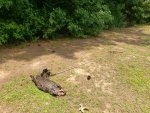redneck_billcollector
Purveyor Of Fine Spirits
Years ago, back in the mid to late 80s as a college and then grad. student I used to fly fish a good bit in northeast GA where I always looked for native brook trout. I had a few spots on public land where I would find them and never saw another fisherman...and they were a relatively short walk from a popular river that had a rather large put and take hatchery fishery. One thing my honey holes had in common were that they were small streams that had beaver ponds, and it was often at the head of those beaver ponds, and in them, where I would catch the most brook trout. That same pattern has served me well when I would go out west and fish the blue line streams that I like to fish. Not only do the western beaver ponds produce a lot of (out there) invasive brook trout, they produce native cutthroats. Fast forward a few decades and I went to find my native brook trout in my old stomping grounds in Rabun County and pretty much all signs of beaver had disappeared from my stream, and with them so had the number of brook trout that were replaced in large part by rainbow trout. I was told by some people that lived in that area that fishermen destroyed those beaver dams apparently in the thought that they impeded trout movement on the stream and, as one old gentleman told me "trout can't live in those swamps". I do not know why, but for whatever reason people seem to think that beaver are bad for trout. Brook trout evolved with beaver, and if the historical accounts are to be believed, it was a rare stretch of water that did not have beaver dams, ponds and swamps on them in GA when Columbus sailed the sea so blue. Beavers are great for water storage, both on the surface and in the ground, and this stored water is released slowly during periods of drought and, at least according to studies, has very little negative impact on water temperature and often has a very positive impact by lowering the water temperature with the release of cooler ground water in the stream bed. I often wondered why T. U. does not encourage beaver restoration when instead I see them often advocating removing beaver dams. Hopefully some day attitudes will change.

